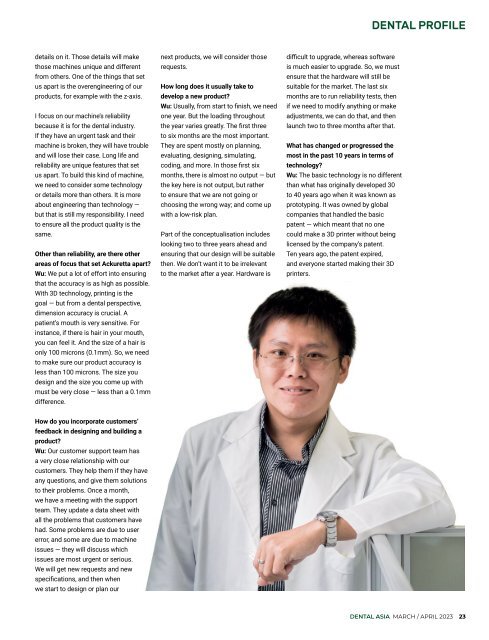Dental Asia March/April 2023
For more than two decades, Dental Asia is the premium journal in linking dental innovators and manufacturers to its rightful audience. We devote ourselves in showcasing the latest dental technology and share evidence-based clinical philosophies to serve as an educational platform to dental professionals. Our combined portfolio of print and digital media also allows us to reach a wider market and secure our position as the leading dental media in the Asia Pacific region while facilitating global interactions among our readers.
For more than two decades, Dental Asia is the premium journal in linking dental innovators
and manufacturers to its rightful audience. We devote ourselves in showcasing the latest dental technology and share evidence-based clinical philosophies to serve as an educational platform to dental professionals. Our combined portfolio of print and digital media also allows us to reach a wider market and secure our position as the leading dental media in the Asia Pacific region while facilitating global interactions among our readers.
You also want an ePaper? Increase the reach of your titles
YUMPU automatically turns print PDFs into web optimized ePapers that Google loves.
DENTAL PROFILE<br />
details on it. Those details will make<br />
those machines unique and different<br />
from others. One of the things that set<br />
us apart is the overengineering of our<br />
products, for example with the z-axis.<br />
I focus on our machine’s reliability<br />
because it is for the dental industry.<br />
If they have an urgent task and their<br />
machine is broken, they will have trouble<br />
and will lose their case. Long life and<br />
reliability are unique features that set<br />
us apart. To build this kind of machine,<br />
we need to consider some technology<br />
or details more than others. It is more<br />
about engineering than technology —<br />
but that is still my responsibility. I need<br />
to ensure all the product quality is the<br />
same.<br />
Other than reliability, are there other<br />
areas of focus that set Ackuretta apart?<br />
Wu: We put a lot of effort into ensuring<br />
that the accuracy is as high as possible.<br />
With 3D technology, printing is the<br />
goal — but from a dental perspective,<br />
dimension accuracy is crucial. A<br />
patient’s mouth is very sensitive. For<br />
instance, if there is hair in your mouth,<br />
you can feel it. And the size of a hair is<br />
only 100 microns (0.1mm). So, we need<br />
to make sure our product accuracy is<br />
less than 100 microns. The size you<br />
design and the size you come up with<br />
must be very close — less than a 0.1mm<br />
difference.<br />
next products, we will consider those<br />
requests.<br />
How long does it usually take to<br />
develop a new product?<br />
Wu: Usually, from start to finish, we need<br />
one year. But the loading throughout<br />
the year varies greatly. The first three<br />
to six months are the most important.<br />
They are spent mostly on planning,<br />
evaluating, designing, simulating,<br />
coding, and more. In those first six<br />
months, there is almost no output — but<br />
the key here is not output, but rather<br />
to ensure that we are not going or<br />
choosing the wrong way; and come up<br />
with a low-risk plan.<br />
Part of the conceptualisation includes<br />
looking two to three years ahead and<br />
ensuring that our design will be suitable<br />
then. We don’t want it to be irrelevant<br />
to the market after a year. Hardware is<br />
difficult to upgrade, whereas software<br />
is much easier to upgrade. So, we must<br />
ensure that the hardware will still be<br />
suitable for the market. The last six<br />
months are to run reliability tests, then<br />
if we need to modify anything or make<br />
adjustments, we can do that, and then<br />
launch two to three months after that.<br />
What has changed or progressed the<br />
most in the past 10 years in terms of<br />
technology?<br />
Wu: The basic technology is no different<br />
than what has originally developed 30<br />
to 40 years ago when it was known as<br />
prototyping. It was owned by global<br />
companies that handled the basic<br />
patent — which meant that no one<br />
could make a 3D printer without being<br />
licensed by the company’s patent.<br />
Ten years ago, the patent expired,<br />
and everyone started making their 3D<br />
printers.<br />
How do you incorporate customers’<br />
feedback in designing and building a<br />
product?<br />
Wu: Our customer support team has<br />
a very close relationship with our<br />
customers. They help them if they have<br />
any questions, and give them solutions<br />
to their problems. Once a month,<br />
we have a meeting with the support<br />
team. They update a data sheet with<br />
all the problems that customers have<br />
had. Some problems are due to user<br />
error, and some are due to machine<br />
issues — they will discuss which<br />
issues are most urgent or serious.<br />
We will get new requests and new<br />
specifications, and then when<br />
we start to design or plan our<br />
DENTAL ASIA MARCH / APRIL <strong>2023</strong> 23


















